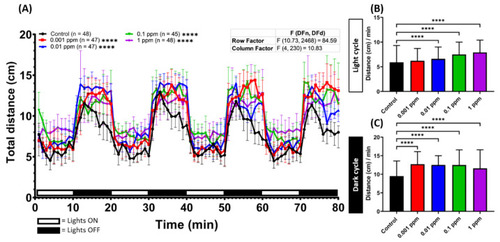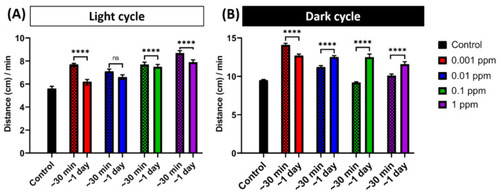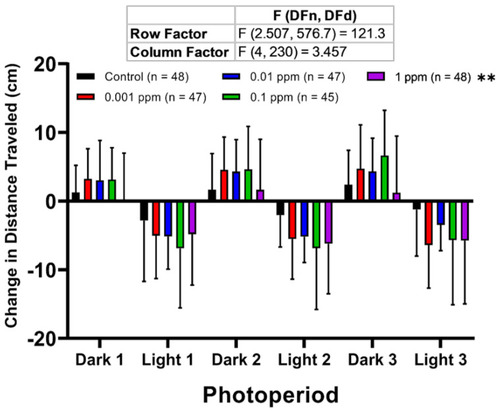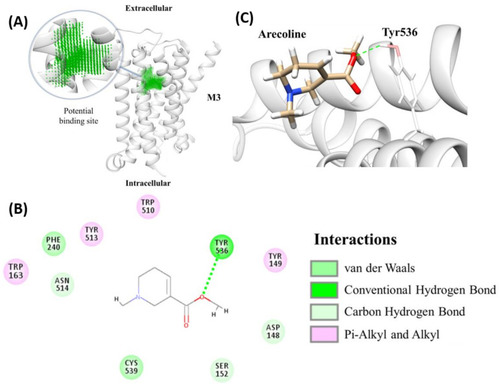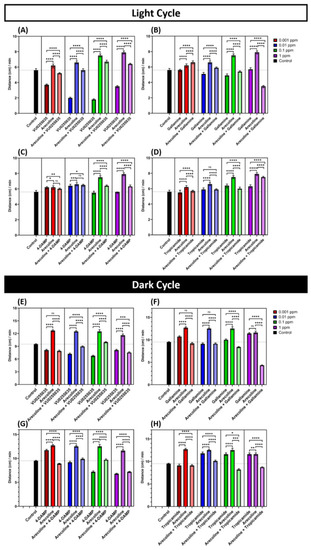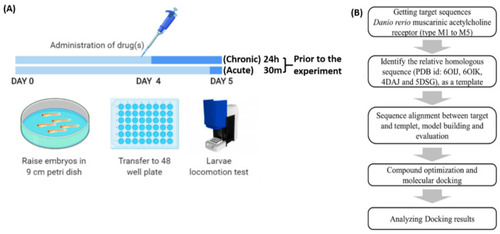- Title
-
Pharmaceutical Assessment Suggests Locomotion Hyperactivity in Zebrafish Triggered by Arecoline Might Be Associated with Multiple Muscarinic Acetylcholine Receptors Activation
- Authors
- Siregar, P., Audira, G., Feng, L.Y., Lee, J.H., Santoso, F., Yu, W.H., Lai, Y.H., Li, J.H., Lin, Y.T., Chen, J.R., Hsiao, C.D.
- Source
- Full text @ Toxins (Basel)
|
Arecoline induced locomotion hyperactivity in zebrafish larvae. (A) Average distance travelled per minute by 120 hpf zebrafish larvae after 1-day exposure of 0 ppm (black), 0.001 ppm (red), 0.01 ppm (blue), 0.1 ppm (green), and 1 ppm (purple) arecoline. The data are expressed as the median ±95% CI and the significance was tested by two-way ANOVA with the Geisser-Greenhouse correction. To observe the main column (arecoline) effect, Dunnett’s multiple comparison test for comparing all treatments with the control was carried out. Total average distance travelled per minute during (B) the light and (C) dark cycles at different arecoline concentrations was compared. The data are expressed as the median with interquartile range and significance was tested by the Kruskal-Wallis test continued with Dunn’s multiple comparisons as a follow-up test. Each treated group was compared with the control group (n = 48 for the control, and 1 ppm arecoline groups; n = 47 for 0.001 and 0.01 ppm arecoline groups; n = 45 for 0.1 ppm arecoline group, **** p < 0.0001). |
|
Comparison of short-term and long-term arecoline exposure on promoting locomotion hyperactivity. Arecoline induced a different pattern of hyperactivity behavior after short-term (30-min) and long-term (1-day) exposure in zebrafish larvae. Total average distance travelled per minute by 120 hpf zebrafish larvae during (A) light and (B) dark cycles after short-term (30-min) and long-term (1-day) arecoline exposure at different dosages were compared. The data are expressed as the median with 95% CI and significances were tested by the Mann-Whitney test. The statistical analyses were conducted between each treated group in every concentration (n = 48 for the control, 1-day exposure of 0.01 and 1 ppm, and 30-min exposure of 1 ppm arecoline groups; n = 47 for 1-day exposure of 0.001 ppm and 30-min exposure of 0.001 and 0.01 arecoline groups; n = 45 for 1-day exposure of 0.1 ppm and 30-min exposure of 0.1 ppm arecoline groups, **** p < 0.0001). |
|
Comparison of the larvae photomotor response (LPMR) for zebrafish larvae after treated with different doses of arecoline. LPMR of 120 hpf zebrafish after 1-day exposure of 0 ppm (black), 0.001 ppm (red), 0.01 ppm (blue), 0.1 ppm (green), and 1 ppm (purple) arecoline. Three LPMRs were measured. The data are expressed as means ± SD of total distance travelled of each following period. Data were analyzed by two-way ANOVA with the Geisser-Greenhouse correction. Each treated group was compared with the control group (n = 48 for the control, 0.01 and 1 ppm arecoline groups; n = 47 for 0.001 ppm arecoline group; n = 45 for 0.1 ppm arecoline group, ** p < 0.01). |
|
Molecular docking of arecoline with endogenous zebrafish muscarinic acetylcholine receptor (mAChR). (A) The identified binding pocket in the middle of the hollow cylinder of the eight sub-types homology modeling structures of mAChR (M3a as an example). Two-dimensional (2D) (B) and 3D (C) illustrations of interactions between arecoline and endogenous zebrafish mAChR M3a showing the hydrogen bond formation between arecoline and mAChR M3a at position Tyr536 (highlighted by the green dotted line). |
|
Muscarinic acetylcholine receptor (mAChR) antagonists can reduce the locomotion hyperactivity triggered by arecoline in the light and dark cycles in zebrafish larvae. ( |
|
Zebrafish locomotor assay to evaluate the arecoline bioactivity workflow overview. (A) Upper panel: Schematic showing the timing for drug administration. Lower panel: Schematic showing the instruments used for drug incubation and locomotion tracking. (B) In silico molecular docking pipeline used to explore the binding affinity between arecoline and Danio rerio endogenous muscarinic acetylcholine receptors (mAChRs). |

